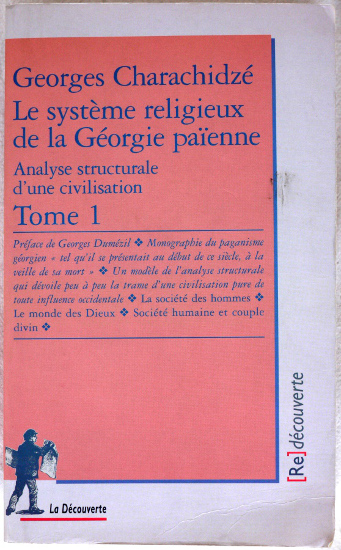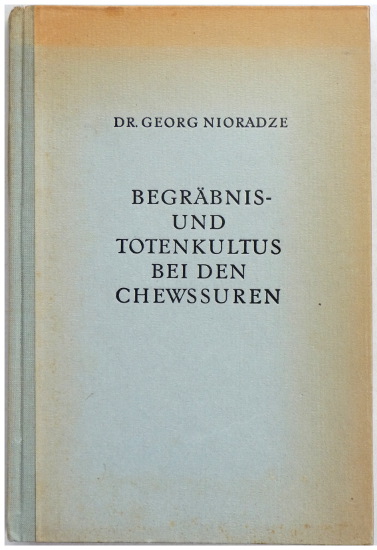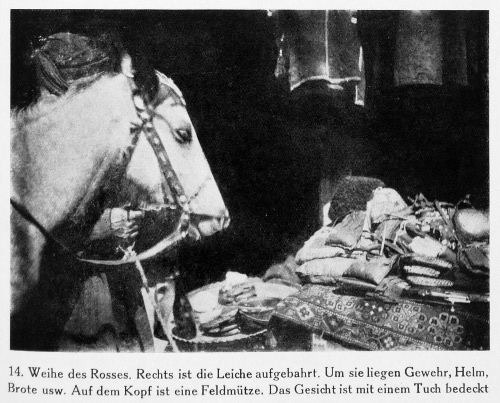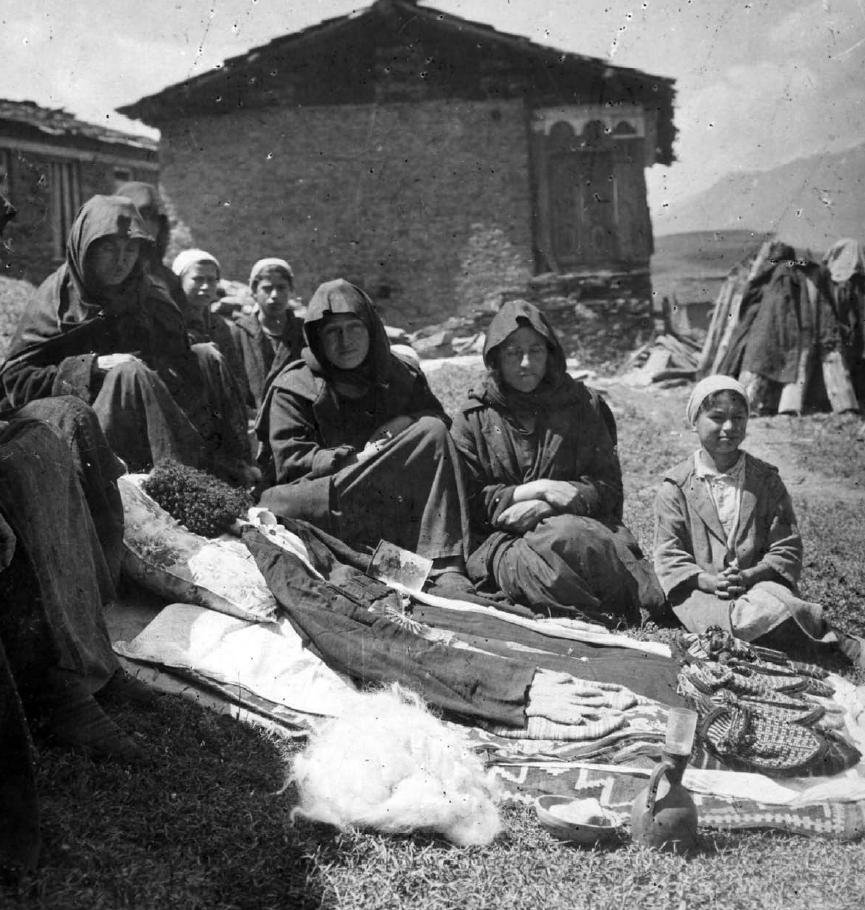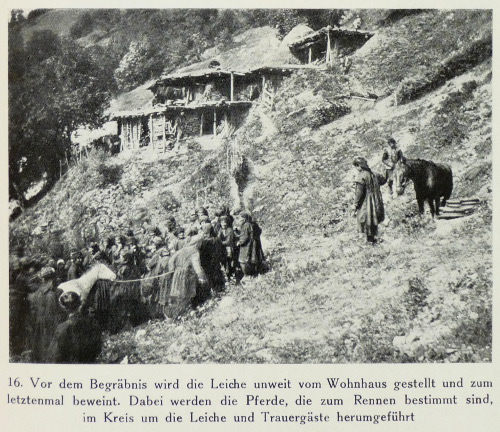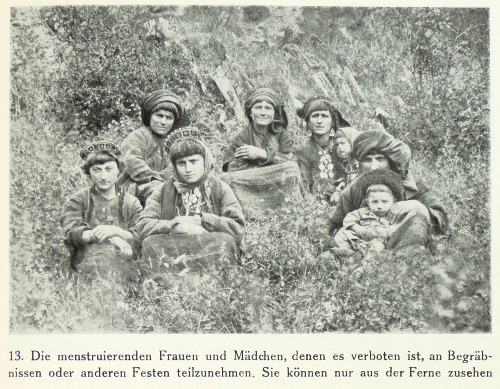ხევსურული დოღი — A Khevsur doghi
GEORGES CHARACHIDZÉ'S DESCRIPTION
OF A FUNERARY HORSE RACE IN KHEVSURETI
—
illustrated with various photographs from other works on the subject
(largely Dr Georg Nioradze's Begräbnis- und Totenkultus bei den Chewssuren)
|
|
|
|---|
The following information was taken from Georges Charachidzé's remarkable Le Système Religieux de la Géorgie Païenne ("The Religious System of Pagan Georgia"), published by François Maspero in Paris in 1968.
In Khevsureti, the death of a young man or woman, or of a young husband or wife with no male descent, was marked by a doghi, a horse race followed by a great banquet, whose main purpose was twofold: the consecration of earthly possessions to the soul of the deceased—i.e. all the things the soul of the deceased would need in the afterlife, such as a horse, weapons and clothes, food and drink, a wife (if the deceased was married), &.—and the reaffirmation of his clanic and family ties on Earth.
According to Charachidzé, the origins of the term doghi are to be found in the Turkish (Turkic) jogh, meaning "funeral". The Ossetes—an Indo-Iranian people dwelling in the northern Caucasus—are believed to have adopted this ritual from the Scythians, and to have conferred upon it its specifically equestrian nature. The ritual was probably passed on from the Ossetes to their neighbours the Pshav and the Khevsur, who in turn brought it to the southern flanks of the Caucasus, where it was adopted by the Tush and other Southern Caucasian peoples.
*
The following detailed description of the rituals which make up such a ceremony tells of a doghi held for the death of a young Khevsur man.
THE DOGHI is the greatest of funerary rites, both in terms of its duration as well as in terms of the quantity of goods the ritual calls for and the exaltation it provokes. It is not held for every funeral: it is reserved for the funerals of young men and women, and for those newly-married without male children. If an old person dies childless, he is not entitled to a Doghi. The demise of a young husband (or wife) who leaves a son behind does equally not give rise to a Doghi, but the death of a single young man or young woman does. If one considers the kind of person whose death calls for a Doghi being held, three necessary conditions appear: to be married, but to have no male child—or, simply, to be young.
The Doghi is both a horse race and the ceremonial consumption of food and drink. These two aspects determine the preparations, which are two-fold: the preparation of the horses which are to take part in the race, and the preparation of the food (and drink) which is to be consumed during the feast. The efficacious agitation with which the Khevsurs surround the horses during the three days which precede the race differs little from the feverish activity ["fièvre magico-sportive"] which reigns over every race-course on the eve of a great competition. Two preoccupations dominate all else: on the one hand, to ensure victory for one's horse by developing its physical capabilities; and on the other, to dispel the forces of evil. Excepting the horse of the deceased, which is called "the soul's horse", all the others are ridden bareback, without saddles. They only bear bits and bridles, and a woman's belt around the waist, with which the riders can steady themselves during the race's rougher passages. But all are decorated with ribbons, that the young women and girls tress into the hairs of their manes and tails; the latter is lengthened by adding a tressed pigtail, to which one attaches a black stone i.e. a piece of manganese. This protects the horse against demons. During the three days of training, the horses are constantly threatened by evil spirits and particularly by the evil eye. Against the evil eye, there exists a ritual—carried out by the "unraveller ["délieur"] of the evil eye"—whom one calls for should the horse exhibit any signs of being possessed: weariness, nervousness, sudden weaknesses in the legs, etc. Notwithstanding these precautions and preparations, the Khevsurs train their horses for three days, and three days only. They make them trot and gallop for several hours every day, and the horses are solely fed hay from the preceding year. If there is no longer any such hay in the village, one goes to borrow some from somewhere else, even from villages very far away. For fresh hay—or, worse still, green grass—would "cut the legs from under the horse". Plants exist in relation with the world of the demons and the evil dead. They play an important role in every movement, every transformation concerned with possession or "de-possession" by demons or the dead. The current year's hay is still too close to nature, too fresh; it is even more dangerous. Last year's hay is dry and is no longer considered as a plant.
*
|
|
An extremely rare photograph taken by Dr Georg Nioradze in Khevsureti in 1927, showing a horse being ritually consecrated and being made the "soul's horse" of a dead man. The photograph's caption reads: |
|---|
*
Charachidzé continues:
The Doghi is a ritual of "delegation", of replacement. All acts are accomplished in someone else's stead; the true "agents" of the action participate by proxy, as do the horses which take part in the race. Every horse represents a specific individual or group of individuals. The number of horses must be odd and cannot be less than five; there is no upper limit, yet it is rare that more than thirteen horses should take part in the Doghi. The star of the show is, naturally, the horse of the soul. When the Doghi takes place, the deceased has already been buried for several days (or months, even, if the Doghi is delayed ["reporté"]). The soul's horse (sulis tskheni) is given to the most accomplished rider of the dead man's clan. Like all the other horses who are to take part in the race, the soul's horse must be a stallion. The Doghi over, the horse must remain in the home. It can only be sold half-price, for it is the double of the horse that the deceased possesses in the afterlife. Khevsurs say: 'If I sell the soul's horse, I will have no horse in the afterlife, for the soul will take mine.' Or, if one does sell the horse, one must buy another for the soul. Khevsurs allow the horse to be given as a present, but only to the nephew of the deceased, to his sister's son. In every Khevsur funerary rite, the maternal uncle has a dominant position; here, the deceased is himself considered in his quality of uncle. In the preparations for the Doghi, however, the deceased is considered the other way round, as nephew. The horses are placed according to a decreasing order of importance: 1. The soul's horse. —2. The horse of the dead man's brother. —3. The horse of the clan of the dead man's wife. —4. The horse of his brothers by oath [i.e. his sworn brothers, as opposed to his blood-brothers]. —5. The horse of his mother's clan. —6. The horse of the narevi [see infra]. —7. The horse of those who wrapped his corpse in its shroud ["revêteurs de suaire"]. If the deceased is a woman, there are variations: —2. The horse of her paternal uncle, her father's brother. —3. The horse of her husband or fiancé. —4. The horse of her father's clan. The horses are not all ridden by those people they are held to represent: Should one of these consider himself not good enough a rider, he employs another, more renowned, whom he is bound to give half of the prize he will receive at the end of the race, the nadoghve. When the horse represents an entire clan—that of the wife, for example—the clan delegates its best rider.
In two cases, a draw is held. If the deceased had several brothers by oath, the latter draw lots to determine which one will represent them all. The other case is that of the narevi, who always draw lots; if the narevi thus designated does not own a stallion, he borrows one in exchange of half of his nadoghve, his prize. The narevi are young men and the still-young men ["les jeunes hommes et les hommes encore jeunes"] of the village of the deceased and of his clan. As soon as the deceased has become "cold" (tsivi, i.e. as soon as he has become a corpse), they assemble in his home and watch over him. They are charged with "taking care of him": to wash him, dress him, and generally-speaking to handle him ["le manipuler en général"]. They are considered to be unclean, and none dare approach them. They are forbidden from washing themselves for as long as these their responsibilities last. Before the Doghi takes place, they purify themselves through ritual cleansing and by sacrificing a sheep to the clan's khati (divinity). Otherwise, they would not be allowed to take part in the Doghi.
The role of the horsemen is extremely important, but another aspect of the Doghi is considered to be equally important: the feasts. As well as preparing "its" horse, every category represented in the Doghi [the deceased man's brother, his wife's clan, his brothers by oath, his mother's clan, &c &c—A.B.] also busies itself with preparing drink, food, and objects. The chief mourner—the head of the deceased man's family—directs the preparations of the sadoghe, i.e. oversees the preparation of all the goods which will be consumed. During the Doghi, at least five feasts will take place in the dead man's house. The number of guests will be extremely high: The first to take part are all the members of the clan who live in the village—men, women, and children. Then, numerous representatives of each of the groups having a horse in the race. And, last but by no means least, the meteme, the representatives of clans from other villages, members of the dead man's temi (his wider clan—brothers by oath, &c). The chief mourner must have hundreds of litres of beer and araq'i, eau-de-vie, brewed and distilled, and he must have several beasts slaughtered: cows, sheep, and goats. He must order the preparation—following certain complex rituals too long to describe here—of cheese, milk mixed with butter, several different sorts of cake, loaves round and star-shaped, and jars filled with saq'eino, beer mixed with butter. The historical literature provides us with no precise figures, but we know that after three days and nights of feasting and drinking, there remains much which the 50 to 100 guests were unable to finish; this is distributed to others, or thrown away. To get a rough approximation of the volume of food and drink called for, one may refer oneself to a curious document from Khevi. In this document, the Mokheve [i.e. the inhabitants of Khevi, notorious to this day in modern Georgia for the alarming gusto with which they eat and, most especially, drink!—A.B.] note that the expense their funerary rites call for is positively ruinous, and decide to diminish the consumption of food and drink and to regulate its amount. For each ritual, they give the new restrictions and the old, pre-regulation amounts. For the kelekhi, the banquet given in honour of the deceased, the text gives the following figures: 'For the kelekhi, one consumes: 1,300kg of bread, 100kg of cheese; one kills two cows, an ox, and some sheep; of beer and of spirits, one consumes as much as the people are able to drink—and you know, reader, that many of the living bury themselves with the deceased.' It frequently occurred that, during funerary banquets, a Khevsur was positively struck down ["foudroyé"] by the quantity of alcohol he had absorbed, or was killed following a drunken brawl or duel.
In addition to those feasts held in the home of the deceased, the chief mourner also prepares the prizes which are to be distributed to the riders of the Doghi following the race. Every rider receives a nadoghve [prize—A.B.] whose importance is relative to his performance in the race. The first—the winner—receives a cow; the second, three sheep; the third, two sheep; the fourth, one sheep and the fifth of a young goat. The others receive lambs, and every rider also receives one or several objects made of copper.
Beer is the clan drink, offered by the members of the dead man's clan to the representatives of other, foreign groups or clans. The latter, on the other hand, offer araq'i, eau-de-vie, in exchange, which they bring in skeins. The food and drink and other objects offered by the chief mourner and destined for the feasts are placed in front of the house and on the roof, whilst those destined to reward those taking part in the Doghi are placed upon a carpet—the t'alavar—which is surrounded by women mourners. The food and drink offered by the other clans are placed away from the carpet, on other tables (t'abla) approximately thirty metres distant. Every clan has its table, called "the horse's table", and on each one are various cakes and bread, all arranged in groups of three, as well as a large amount of cheese and of butter floating in dishes of milk. Next to the table are several buckets of eau-de-vie. The clan in mourning also sets up a "horse's table", but next to the dead man's carpet, and not with the other clan tables.
The "horse's table" belonging to related clans is set up on the way leading out of the village, on the path of the race. Several foreign clans contribute to this offering of eau-de-vie; these are all the groups who have a horse in the race. At this table, one would find the clan of the dead man's maternal uncle, and that of his wife. It also often happens that one of the dead man's brothers by oath (dzmobili) belongs to a foreign group or clan, and this group or clan would constitute a third party. The presence of the maternal uncle's clan and that of the widow is compulsory, but representatives of other clans are often also present: the sons of the dead man's maternal aunt, and those of his paternal aunt, for example, whose presence would add another two foreign clans, and therefore another two "horse's tables". Lastly, the clans of the dead man's married sisters often also take part in the Doghi, which accounts for the fact that the number of horses and corresponding tables is almost always greater than the required minimum of five, and often reaches twelve or thirteen. One must also note that the dead man's clan often also has a horse in the race, in addition to the "soul's horse", and that consequently they must also set up a "horse's table" as another foreign clan. The respective places of the different clans are also noteworthy: the table of the dead man's clan is placed next to the dead man's carpet; that of the related clans (the meteme) is placed on the way leading out of the village; and the tables of the foreign clans are grouped halfway between the latter two:
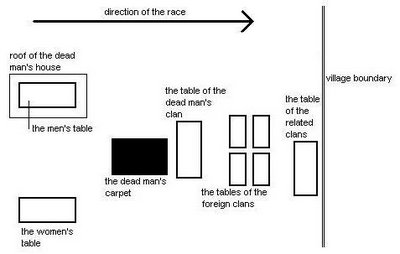
When one considers the order in which the tables are placed, it becomes apparent that the dead man's lineage and those of his allies are considered as foreign, as strangers, despite the fact that, at the same time, they clearly distinguish themselves from the latter. The dead man's relatives occupy both ends of an axis; his clan occupy the centre; and his allies the periphery; whilst the foreign clans occupy an intermediary position on the axis.
The horses therefore first halt at the clan's table, then at those of the strangers, and finally at that of the allies. This ceremony of the t'abla also consists in "blessing" and "consecrating" the horses. The ceremony confers upon them their final, definitive role; it "names" them. It begins in front of the dead man's carpet. The "soul's horse" is brought here, its bridle held by the dead man's wife (or mother, should he have no wife). The horse is equipped: weapons, marching provisions, eau-de-vie, clothes. A table is set up in front of it, with cheese, bread, beer, and eau-de-vie. (This table is distinct from the other "horse's tables".) The soul's priest, a horn of araq'i in his hand, speaks to the deceased:
'There where you are, Toghva [for ex.], this one [the horse] is for your use; be not sad, for you will not be alone without a horse among your companions; with this horse you will be among your companions, valiant and joyful.'
The priest then pours the eau-de-vie in the horn onto the horse's mane, and as he strikes it three times with a riding-crop, he says: 'You will be for his use among his companions, among their horses.' Here, the priest employs the word mgebrebi, which signifies "companions", "friends", but in a special sense, for he is referring to the [male members of the] dead man's family who will greet him in the afterlife, accompany him to the clan's resting place, and will take care of him during the first few days. These are the doubles—in the afterlife—of the narevi on Earth: the narevi helps the dead man to leave his living clan, whilst the mgebari helps him to join those of his clan who have died. This ritual of striking the horse with a riding-crop consecrates the horse, and ritually sends it to serve its master in the afterlife, to take its place among the horses of the dead man's mgebrebi. The widow then also strikes the horse three times, and adds: 'May this horse and this table serve you in the afterlife.' If the deceased leaves a widow without a son, the priest—having consecrated the horse—also consecrates the wife; he strikes her, too, three times with the riding-crop, and says: 'May this your wife also be your wife in the afterlife.'
This ceremony complete, each rider takes his horse by the bridle, and—in the above-mentioned order—they advance towards the different t'abla. The riders must then devour everything that was placed upon the tables, and drain the buckets of eau-de-vie. The way in which they proceed [from table to table, from clan to clan—A.B.] shows that this is not merely the consumption by every rider of his own clan's table of food and drink, but an exchange, a circulation of wealth, and that this is not so much an orderly exchange, but a confusion. Every rider must "grab" ["arracher"] dishes from each table in turn, and drink from every bucket of eau-de-vie. In this manner, the possessions of all the clans present fuse into a single consumption. As all the t'abla compete among each other in abundance, there is far too much food and drink for the riders to consume; the riders generally succeed in draining all the buckets of eau-de-vie, but a lot of the food remains uneaten. These leftovers are buried away from the village. The riders, sated (and—more often than not—by now completely drunk), mount their horses, and—under the leadership of the soul's priest, and in the afore-mentioned order—mark three circles around the women, who are themselves seated in a circle around the t'alavar, the "dead man's carpet".
*
A t'alavar photographed in Tusheti—the deceased as ritually represented by his clothes laid out on a carpet, and accompanied by a pitcher of wine with a glass, a bowl containing some cheese, a small pile of wool, &c. i.e. things which he will need in the afterlife. (Note the photograph placed next to the dead man's chest; please click for a larger image.) |
|
|---|---|
|
Another extremely rare photograph taken by Dr Georg Nioradze during his journey to Khevsureti in 1927, showing the riders marking 'three circles around the women, who are themselves seated in a circle around the t'alavar' (Charachidzé). The photograph's caption reads: |
|
*
Charachidzé continues:
Following this ritual, the riders gallop off in the direction of the village chosen as the starting-point of the race, many kilometres distant. As they leave, all their weapons are taken from them, with the exception of their daggers. The gallop the entire way, without saddle, without harness, through the inky night, over the mountains, and after several hours, the riders arrive in a foreign clan in the middle of the night. Their hosts from the foreign clan have been waiting for them at the entrance to their village, next to a "horse's table" bedecked with bread, cheese, and beer.
Once the riders (and their horses) have partaken of this symbolic meal, their host clan invites them to a great feast held in their honour; the entire village takes part, and makes merry. Then, after a very short rest, the riders assemble before dawn on the starting-line, i.e. before the t'abla where they were received the day before, the "horse's table"; their return journey—the true race—now begins! Hours later, when the riders finally reach the finishing-line, the dead man's house, the horses are exhausted. The rider has the right to rip the bridle from his mount, jump off, and—bridle in hand—to run to the finishing-line. The bridle suffices to "represent" the horse. The racers, according to their achievement, receive their nadoghve; their rewards are never disputed, for the prizes—cow, sheep, copper objects, &.—have been carefully and meticulously awarded by an expert in such matters, the medoghe. He is the judge, the race's referee, and his decision is final. Having been awarded their prizes, the riders lead their horses by the bridle, and mark several circles around the house, applauded and cheered by the crowd of onlookers. The chief mourner invites them into the house, where they are feasted until night falls. During this, their banquet, they hand over their prizes to the clans in whose name they were racing; the latter then returns the rider's half—or, rather, recognizes the debt owed him, an amount equivalent to one half of the nadoghve. And it is at this banquet, which marks the end of the Doghi, that the representatives of the various clans attempt to bring an end to quarrels and blood feuds, vendettas—in one word, to reconcile the various groups. Historical sources do not mention exactly who is present at this, the final feast, but indicate that attendance is open to all without distinction. It is a chaotic event, and does not so much constitute the end of the Doghi as it reflects its result. This confusion of clans, sexes, and age-groups, these reconciliations and agreements one seeks to effect, are in strong contrast to the previous day's feasts.
While the riders were galloping, between their departure and their return, the guests of the village have not ceased their feasting. From the moment when the riders left the village, the Doghi divides itself into two parts: the race itself, which we have described above; and the consumption of wealth (i.e. food and drink) at the dead man's house. The horses having galloped away, the women are still seated in a circle around the t'alavar. The men remove their weapons and hand them to young girls, who go to hide them in various safe places. The Khevsurs who go to visit a foreign clan, and those who receive them there as guests—i.e. all the men, without distinction—are armed from head to toe: chain-mail, rifle, sword, pistol, shield, lance, or matrakhi (mace). Once relieved of their weapons, they nevertheless keep their dagger, with which a Khevsur never parts. This customary "disarming" can be interpreted as a preventive measure destined to forestall duels; these take place with the dagger alone, handled with gusto ["manié d'estoc et de taille"], like a sword. Whilst the women remain seated around the t'alavar, the men take their seats at a banquet held on the roof of the dead man's house. The latter then send down a jar of beer to the women. During this feast, the women are referred to as the dedrovanni, "the feminines", and the men as mamrovanni, "the masculines". The women drink the beer, which they dedicate to the dead man. They then also dedicate the eau-de-vie placed among them to him. Having done so, they enter the dead man's house. The "masculines" are already seated at their table upon the roof. The "feminines" must wait until the men have finished eating, after which they too seat themselves for their banquet, which is held downstairs, on the ground floor. Every guest has next to him a dish of melted butter, the khavitsi, which is replenished as soon as it is empty by the "standing people" (zedemdegebi), i.e. the young people who wait upon them. For every two or three guests, there stands a jar of beer, which is also refilled as soon as it is empty. The men are seated upon benches placed around a wooden table, upon which the dishes are stacked high. When these begin to diminish, the "standing people" bring more. The mearaq'e ply the guests with araq'i, [arak, i.e. eau-de-vie]; the mearaq'e are those men from foreign clans who have brought arak to the Doghi in skeins. The women are waited upon by women, and the men by men. The waitresses pour the women cups of eau-de-vie, but not beer, which is brought to them by men.
The dead man also takes part in this vast process of consumption, but he does so indirectly, by proxy. On the eve of the Doghi, the chief mourner chooses three of his clansmen, and informs them that they will be replacing the dead man at the feast, and that they will have to prepare themselves by fasting. These are the three p'iris mtch'erni, "those who hold the mouth". If the soul is that of a man, the p'iris mtch'erni are two men and a woman; if that of a woman, two women and a man. They are the first to eat and drink at the feast. They attack the food with gusto, and must not forget to try every dish brought to the table. They are generally chosen from among the greatest eaters of the village, so that they may—representing the dead man—devour an enormous quantity of food. These substitutes of the soul only appear at the main banquet of the Doghi, and play no role during the equestrian half of the ritual, since during the horse-race itself the dead man is represented by his horse. During the feast, the p'iris mtch'erni are divided among the guests according to their sex.
When the men have finished eating—or, at least, when they declare that they have finished—a great dish of beer mixed with butter (saq'eino) is passed around the table, and every man present takes a sip. Only then do the men rise and leave their table. This done, the women begin their banquet; they sit down in the house, on the ground floor, without table or benches. They squat down next to their tablecloth, which is spread out upon the very earth. Their meal is held along identical lines to that of the men, with the exception that their beer is served by a man. At the end of the meal, the "mistress of the mourners" ["la maîtresse des pleureuses"] rises, and whilst the jar of saq'eino is being passed around, she says: 'May that which is being passed around be consecrated to you, you the maternals [dedulta].' Then, she addresses the mgebrebi, those souls which accompany the dead man's soul to the afterlife. This done, the women rise and leave the house. Outside, in front of the door, the male servants await them with cups full of beer. They force them to empty at least one or two cups. To prevent the women from leaving through another, back-door, a sword is placed across the main threshold. The Khevsurs believe that a woman possessed by the devil—or, more exactly, "a woman with a tail" (the term k'udiani, "with a tail", refers to the devil)—cannot pass the sword. So, afraid of being accused of being "a woman with a tail", the women prefer to step over the sword, and drink the beer.
When everyone is leaving, the mek'are—the woman responsible for the relationship between the family and the isolated impure women—brings the latter food and drink, for they are not allowed to take part in the Doghi, which they watch from afar. They are served beer in wooden cups. If anyone in the village was too old or too ill to take part in the Doghi, his or her share of the feast is delivered to them. When the shepherds return with their flocks, a table is set up for them, and they feast and celebrate as they would have done during the Doghi. The "standing people" [i.e. the young men and women who waited upon everyone else] also have their feast. Indeed, everybody in the village is bound to take part in the feast, and to seat themselves—even if only symbolically—at a t'abla. The accumulation of wealth for a Doghi only has meaning in its destruction: the more food and drink is consumed on Earth, the more the dead will have in the afterlife. This exaggerated consumption moves some Khevsurs to imbibe prodigious amounts of alcohol, egged on by the others. Many men become absolutely blind drunk, and are easily provoked by any perceived slight to their finely-tuned sense of honour; duels and brawls are inevitable. These are always bloody, for the Khevsur conceives of no fight without his dagger. Indeed, it seems likely that these fights are held to be an essential part of the ritual, and that—at the very least—nothing is done to prevent them from happening, for a Doghi without a fight, one where blood is not shed, is considered to be a failure. If a fight breaks out, the chief mourner rejoices: 'The dead man is exciting the people!' ["le mort agite les gens"] If the deceased is a man, one says: 'All his life, he was an indefatigable quarreller, and now he continues to be so in the afterlife.' If the fight becomes a brawl and if people are injured, 'the old men congratulate the dead – for the dead are fighting, too, and it is they who make the living fight among themselves...'
|
|
Another photograph taken by Dr Georg Nioradze during his time in Khevsureti in 1927, showing a group of menstruating women and their children watching a funeral; because of their condition, they are deemed ritually impure and are not allowed to approach others. The photograph's caption reads: |
|---|
Unless stated otherwise or obviously not the case, all the text and images on this website are © A.J.T. Bainbridge 2006-2014
Do get in touch! Gmail: alexjtb

